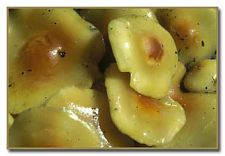Flammulina velutipes
 Velvet Foot or Winter Mushroom
Velvet Foot or Winter Mushroom
(F. populicola grows with Populus in western NA)
Order Agaricales, family Physalacriaceae
CAP STICKY, YELLOWISH TO ORANGE-BROWN
Cap: 1-5 cm wide; convex to flat with knob; cap edge incurved at first; smooth, slimy; yellow brown, orange-brown, or tawny, margin often paler
GILLS WHITISH
Gills: attached; close, broad; white to pale yellow
 STALK DARK BROWN AND VELVETY BELOW
STALK DARK BROWN AND VELVETY BELOW
Stalk: 2-11 cm long, 3-5 mm thick; tough; brown, velvety from base upward as matures
SPORE PRINT WHITE
7-9 x 3-4 µm, elliptical, smooth
IN CLUSTERS ON DEAD HARDWOOD
EDIBLE. BEWARE OF LOOKALIKES
Lookalike:
Galerina autumnalis (deadly) -- brown spores, ring on stalk, common in mountains but not in the city
YOU MIGHT ALSO LIKE TO KNOW...
The velvet foot is widely cultivated and consumed in Japan where it's called enoki-take (ee-no-key tah-key). Many Japanese believe it prevents or retards tumor formation and growth. The cultivated form, which is off-white to cream colored and shaped like a long-stemmed nail, doesn't really have much of a flavor. But it does add an aesthetic touch, a shape, a texture, and a color to off-set other heavier and darker foods.
The wild, urban velvet foot looks completely different and has much more flavor than its pale-faced cousin. It looks so different, in fact, that a Japanese-American—who eats the cultivated enoki-take regularly—refused to believe a mushroom expert who told him that wild enoki-take was growing in his yard, free for the picking!
It's called the "winter mushroom" because it grows out of tree stumps during late fall, early winter and early spring. Sometimes it will emerge after the first storm of winter, if the temperature doesn’t stay below freezing too long. It is also called "velvet foot" because of the dark velvety appearance of the stem.
Once, well into the winter, after days of freezing weather, our neighbor told us about a big fruiting of enoki-take on a stump near his house. We called Norm Birchler, a mushroom friend of ours, who picks forest-growing matsutake for a man he knows who runs a Japanese restaurant. We asked if we could bring in the enoki-take. Norm suggested we meet for dinner at the Japanese place and bring in the mushrooms. We picked them, took them to the restaurant, and the chef prepared our enokes in a light garlic sauce, thickened with corn starch. Truth be told, the dish sucked, but the experience of picking the mushrooms in the dead of winter and bringing them to the cozy restaurant was five-star.
If you can't find velvet foot in the city, and you're getting desperate to pick some, buy a kit from Fungi Perfecti (fungi.com) so you can grow your own on your kitchen table.
 The velvet foot is a small but mighty mushroom that I believe is grossly underrated and sometimes flatly ignored in most cookbooks. It's true the cultivated version -- the pure white enoki -- has almost no flavor, but the wild velvet foot is one of my favorites. It is often the first mushroom of spring, fruits in the high country in summer when all other fungi have gone dormant, and can be found in the autumn after the chanterelles and boletes are long gone. When lightly sauteed, the caps -- which are slightly viscid -- release their thick, sauce-like liquid. The texture is good whether the mushroom is served hot or cold.
The velvet foot is a small but mighty mushroom that I believe is grossly underrated and sometimes flatly ignored in most cookbooks. It's true the cultivated version -- the pure white enoki -- has almost no flavor, but the wild velvet foot is one of my favorites. It is often the first mushroom of spring, fruits in the high country in summer when all other fungi have gone dormant, and can be found in the autumn after the chanterelles and boletes are long gone. When lightly sauteed, the caps -- which are slightly viscid -- release their thick, sauce-like liquid. The texture is good whether the mushroom is served hot or cold.
The nasturtium flowers in this recipe add color, a slight peppery taste, and enhance the mushroom's light, somewhat buttery flavor. Yes, you can eat nasturtium flowers and leaves. (The flower buds are pickled and sold in groceries.) Nasturtiums can be grown in window pots. That’s important to know because once you start eating nasturtiums, I think you’ll want a steady supply.
Velvet Foot and Pepper Flower Salad
1 C velvet foot caps
1 t butter
1 T water
½ C nasturtium leaves
3-4 lettuce leaves
8 slices red bell pepper
12 nasturtium flowers
Dressing
2 T olive oil
2 T fresh lemon juice
2 T mild rice vinegar
1/8 t grated fresh lemon peel
1/8 t grated fresh ginger
1/2 t sugar (to taste)
pinch of salt
Saute mushrooms slowly in butter and water. Combine all dressing ingredients and pour over sauteed mushrooms and marinate in the refrigerator while you prepare the salad greens. Toss the lettuce and nasturtium leaves together. Divide in two and place in the center of two salad plates. Arrange the sweet pepper slices around the outer edge of the plates and spoon the marinated mushrooms onto the center of the greens. Top with the flowers. Serves two.



